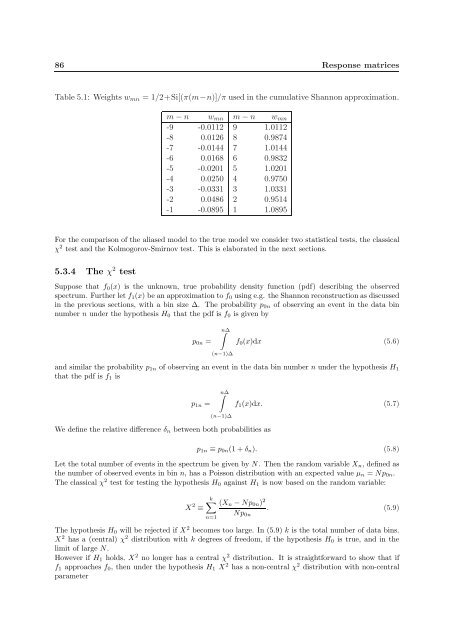SPEX User's Manual - SRON
SPEX User's Manual - SRON
SPEX User's Manual - SRON
Create successful ePaper yourself
Turn your PDF publications into a flip-book with our unique Google optimized e-Paper software.
86 Response matrices<br />
Table 5.1: Weights w mn = 1/2+Si[(π(m−n)]/π used in the cumulative Shannon approximation.<br />
m − n w mn m − n w mn<br />
-9 -0.0112 9 1.0112<br />
-8 0.0126 8 0.9874<br />
-7 -0.0144 7 1.0144<br />
-6 0.0168 6 0.9832<br />
-5 -0.0201 5 1.0201<br />
-4 0.0250 4 0.9750<br />
-3 -0.0331 3 1.0331<br />
-2 0.0486 2 0.9514<br />
-1 -0.0895 1 1.0895<br />
For the comparison of the aliased model to the true model we consider two statistical tests, the classical<br />
χ 2 test and the Kolmogorov-Smirnov test. This is elaborated in the next sections.<br />
5.3.4 The χ 2 test<br />
Suppose that f 0 (x) is the unknown, true probability density function (pdf) describing the observed<br />
spectrum. Further let f 1 (x) be an approximation to f 0 using e.g. the Shannon reconstruction as discussed<br />
in the previous sections, with a bin size ∆. The probability p 0n of observing an event in the data bin<br />
number n under the hypothesis H 0 that the pdf is f 0 is given by<br />
p 0n =<br />
∫n∆<br />
(n−1)∆<br />
f 0 (x)dx (5.6)<br />
and similar the probability p 1n of observing an event in the data bin number n under the hypothesis H 1<br />
that the pdf is f 1 is<br />
p 1n =<br />
∫n∆<br />
(n−1)∆<br />
f 1 (x)dx. (5.7)<br />
We define the relative difference δ n between both probabilities as<br />
p 1n ≡ p 0n (1 + δ n ). (5.8)<br />
Let the total number of events in the spectrum be given by N. Then the random variable X n , defined as<br />
the number of observed events in bin n, has a Poisson distribution with an expected value µ n = Np 0n .<br />
The classical χ 2 test for testing the hypothesis H 0 against H 1 is now based on the random variable:<br />
X 2 ≡<br />
k∑ (X n − Np 0n ) 2<br />
n=1<br />
Np 0n<br />
. (5.9)<br />
The hypothesis H 0 will be rejected if X 2 becomes too large. In (5.9) k is the total number of data bins.<br />
X 2 has a (central) χ 2 distribution with k degrees of freedom, if the hypothesis H 0 is true, and in the<br />
limit of large N.<br />
However if H 1 holds, X 2 no longer has a central χ 2 distribution. It is straightforward to show that if<br />
f 1 approaches f 0 , then under the hypothesis H 1 X 2 has a non-central χ 2 distribution with non-central<br />
parameter

















